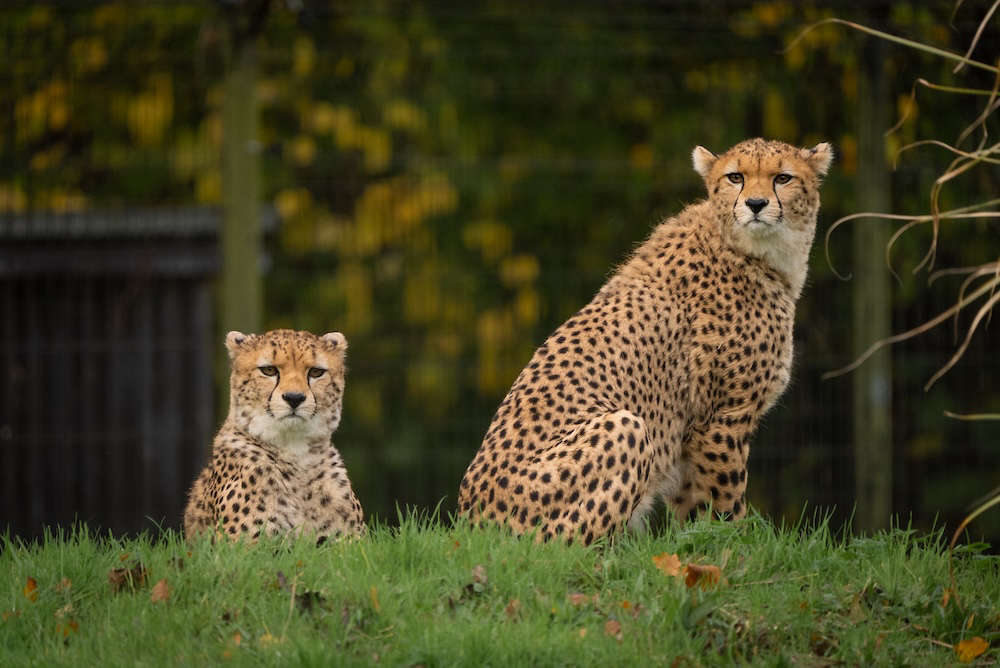Two female bat-eared foxes have arrived at Chester Zoo - the first of their kind to be seen at the zoo in more than 30 years.
The two sisters, named Maasai and Malindi, have been welcomed by the zoo’s conservationists after travelling more than 500 miles from a zoo in Paris, France.
First images show the pair exploring their home at Chester, located in the zoo’s new Heart of Africa habitat – the largest zoo development ever undertaken in the UK, spanning more than 22.5 acres in size.
The species is named after its distinctive oversized ears and is endemic to the open savannahs and arid grasslands of eastern and southern Africa. In the wild, bat-eared foxes face increasing threats, largely due to habitat loss caused by agriculture, human encroachment and hunting.
Zoo experts say that, in future, they plan to introduce one of sisters to a male fox and go on to play a vital role in the conservation breeding programme that is working to safeguard the species.
David White, Team Manager at Chester Zoo, said:
“It’s incredibly exciting to welcome bat-eared foxes back to Chester Zoo after a 30-year hiatus and they’re a wonderful addition to our new Heart of Africa habitat. They’re a truly unique and fascinating species with some amazing adaptations.
“Their enormous ears aren’t just for show – they act like satellite dishes and help the foxes detect the tiniest of movements coming from insects beneath the ground, allowing them to detect prey with pinpoint accuracy. They’re so sensitive that they can even hear termites chewing underground!
“Both Maasai and Malindi are settling in well so far, spending much of their time exploring their expansive home and getting to know their new housemates – a family of 12 Cape porcupines. These two species would often come across one another in the wild, so we’ve recreated this right here at Chester. In time, we hope to introduce one of the two sisters to a male fox, with the hope that we can contribute to the European conservation breeding programme - helping to ensure there’s a healthy, genetically diverse back-up population in human care.
“Like many species found in the Arican savannah, bat-eared foxes are under threat as their habitat becomes more fragmented as a result of human activity. That’s why our teams are on the ground in several national parks across Kenya and Uganda safeguarding some of the continent’s rarest species like northern giraffe, giant pangolins, mountain bongo and Eastern black rhino. By protecting these species and their habitats we’re also helping many of Africa’s little known species like bat-eared foxes, that share the same habitats, to go on to thrive once again.”
The zoo has long been at the forefront of protecting African wildlife, from supporting the safe translocation of northern giraffes to protected national parks in Uganda, to developing cutting-edge AI trail cameras to protect giant pangolins from illegal trafficking. It’s teams’ pioneering endocrinology science is helping to increase eastern black rhino populations in Kenya and it supports initiatives like the Maasai Olympics, a sporting event where the culture of hunting lions has been replaced with sport, seeing lion numbers grow tenfold since 2012.
Bat-eared fox fact file:
- Scientific Name: Otocyon megalotis
- Habitat: Grasslands, savannahs, and arid regions of eastern and southern Africa
- Diet: Primarily insectivorous – they feed mainly on termites, beetles and other small invertebrates
- Lifespan: Up to 13 years
- Fun Fact: Their large ears help regulate body temperature and enhance their incredible hearing, allowing them to detect insects moving underground!
- Threats: Habitat loss due to agriculture, human conflict, and hunting

 Blues Match Report: Chester FC 1 - 1 Marine
Blues Match Report: Chester FC 1 - 1 Marine
 Wanted man from Ellesmere Port arrested and charged
Wanted man from Ellesmere Port arrested and charged
 'Winter Warmer' initiative for local over 60’s in North Wales
'Winter Warmer' initiative for local over 60’s in North Wales
 Inaugural meeting of the Cheshire and Warrington Combined Authority Shadow Board
Inaugural meeting of the Cheshire and Warrington Combined Authority Shadow Board
 Cheetah brothers arrive at Chester Zoo
Cheetah brothers arrive at Chester Zoo
 Ex-Chester FC star helps create stunning poppy tribute
Ex-Chester FC star helps create stunning poppy tribute
 FREE CHESTER CONCERT SET TO CELEBRATE WORK OF RENOWNED NORTH WEST BASED COMPOSER
FREE CHESTER CONCERT SET TO CELEBRATE WORK OF RENOWNED NORTH WEST BASED COMPOSER
 MUSIC BY RENOWNED WELSH FEMALE COMPOSER TO FEATURE IN WREXHAM ORCHESTRA REMEMBRANCE CONCERT
MUSIC BY RENOWNED WELSH FEMALE COMPOSER TO FEATURE IN WREXHAM ORCHESTRA REMEMBRANCE CONCERT
 Blues Match Report: Cambridge United 3 - 0 Chester FC
Blues Match Report: Cambridge United 3 - 0 Chester FC
 Blues Match Preview: Cambridge United v Chester FC
Blues Match Preview: Cambridge United v Chester FC
 Cheshire Constabulary welcomes its newest four-legged crime fighter ahead of her Police Dog training
Cheshire Constabulary welcomes its newest four-legged crime fighter ahead of her Police Dog training
 Appeal to trace wanted man from Ellesmere Port
Appeal to trace wanted man from Ellesmere Port
 Lord Mayor of Chester and Chair of CWaC to lead Chester’s Acts of Remembrance
Lord Mayor of Chester and Chair of CWaC to lead Chester’s Acts of Remembrance
 Ellesmere Port Market unveils local schools’ artwork display
Ellesmere Port Market unveils local schools’ artwork display
 Children in Chester no longer need to travel for life-saving breathing support
Children in Chester no longer need to travel for life-saving breathing support
 Academics hike for fundraising effort close to their hearts
Academics hike for fundraising effort close to their hearts
 Local musician releases his new single on Halloween
Local musician releases his new single on Halloween
 Local MP Launches Annual Christmas Card Competition
Local MP Launches Annual Christmas Card Competition
 Residents in Chester’s Garden Quarter to decide whether they should change their parking arrangements
Residents in Chester’s Garden Quarter to decide whether they should change their parking arrangements
 Man jailed for role in courier fraud
Man jailed for role in courier fraud
Comments
Add a comment